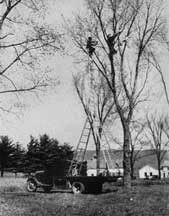New Trees For Our Forests, Page 2
By DOROTHY PARKER ROWE
The technique for controlled breeding of forest trees is similar to that for breeding agricultural and horticultural plants. Above all, it is essential to protect the unopened flowers from chance pollination, both before and after the desired pollination is made. Glassine and kraft paper bags turn the trick.
If you are interested in the procedure of tree breeding, come around in the spring of the year. About two weeks before the female flowers of the tree you are going to pollinate have opened, you are perched on a ladder in a treetop, placing a glassine bag over a branch where the flower buds are visible. You must be sure to tie the bag securely over a bit of cotton wrapped around the stem. Next, tie a stout kraft paper bag over the glassine bag for added protection. Later, you have to make at least two or three more trips to the forest in order to catch the flowers in exactly the right condition for pollination.
Once again you are balancing yourself on the ladder. This time you note that the female flowers are receptive and you are ready to dust pollen which you have laboriously collected from male flowers of another tree on the flowers of the female parent you have selected. The pollen is handled in small vials stored in air-tight containers along with chemicals to maintain proper moisture conditions, and you do the dusting with a finely-pointed medicine dropper.

POLLINATING THE TREES CALLS FOR SOME ACROBATICS
First, you puncture the glassine bag with the medicine dropper containing the pollen, and, after shooting in the pollen, you must tie another glassine bag, as well as a kraft bag, around the flowering branch for protection until the flower is past bloom. Before the seeds have ripened you will have to cover them with a cloth bag so none will be lost. After the seeds have ripened, they have to be collected which means still another game of hide and seek in the treetop.
It may sound easy, if you go in for gymnastics. But oh! Those aching arches jammed against the ladder rung; not to mention the mental strain of the novice, wondering whether his safety belt will hold! Probably you decide to experiment with violets after all.
It takes a long time to "fix" a new plant so that it will "come true to seed," and the forest tree breeder tries to utilize a short cut that is possible with trees that can be propagated vegetatively from cuttings.
If the young stems of a poplar are cut in short lengths and the pieces planted in the ground, hundreds of thousands of plants can be produced from one individual within a few years! By this method all the excellent characteristics of the elite hybrid can be utilized immediately since every cutting will produce a tree exactly like its parent. Fortunately, research is showing that many tree species that do not root from cuttings naturally, can be induced to take root after treatment with growth-promoting chemicals.
 Printer-friendly version
Printer-friendly version
